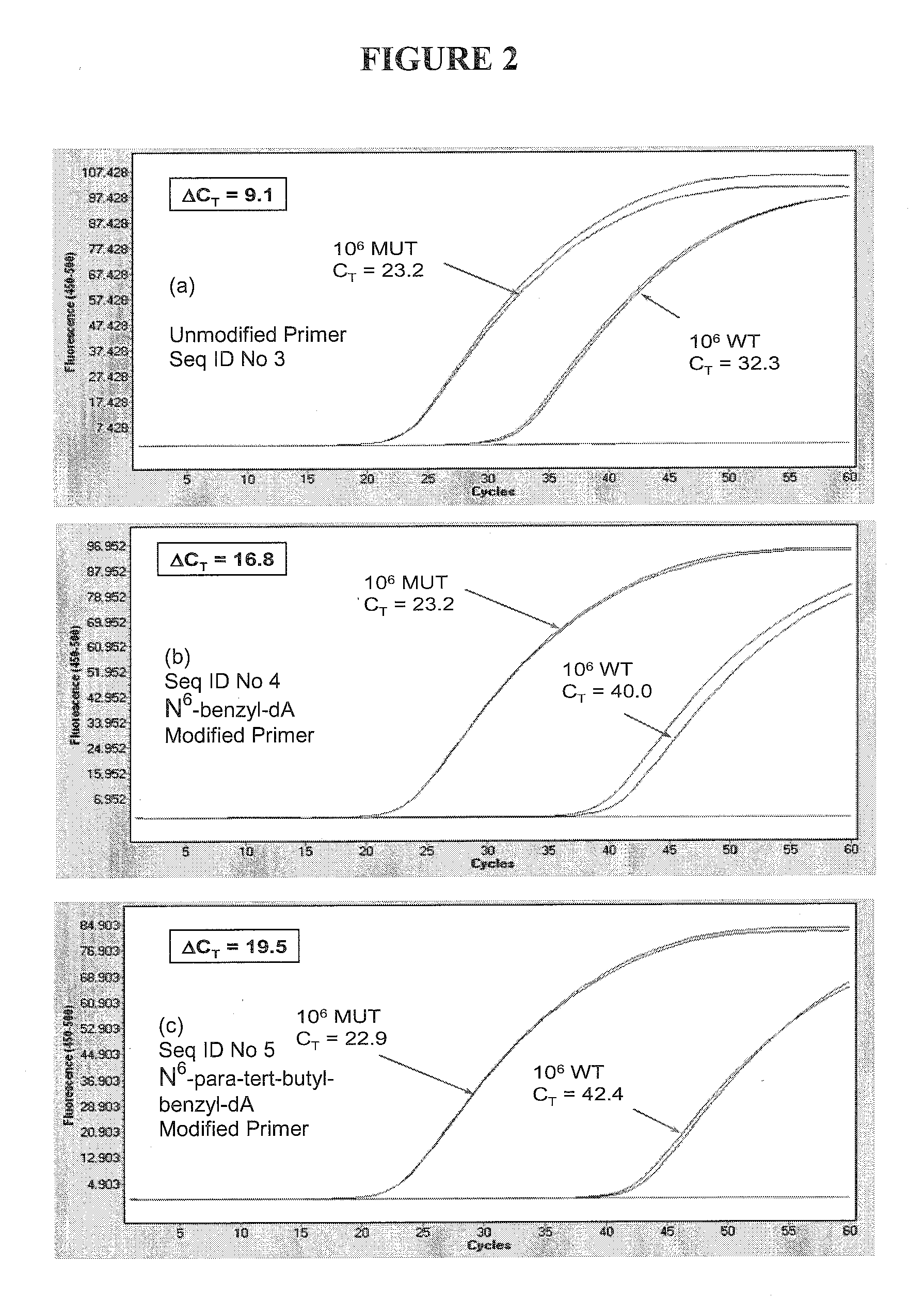Allele-Specific Amplification
a technology of alleles and amplification, applied in the field of allele-specific amplification, can solve the problems of poor selectivity of allele-specific pcr, 7-cycle delay in amplification of mismatched templates, and insufficient discrimination for many
- Summary
- Abstract
- Description
- Claims
- Application Information
AI Technical Summary
Benefits of technology
Problems solved by technology
Method used
Image
Examples
example 1
Allele-Specific Amplification Using Primers with Internal Base Modifications
[0093]In this example, two variants of the template sequence were present in equal amounts, a matched variant, complementary to the primer sequence and a mismatched variant. The matched variant was a plasmid DNA with the insert incorporating the BRAF V600E mutant sequence (SEQ ID NO: 1), while the mismatched variant was the same plasmid with the BRAF wild-type sequence (SEQ ID NO: 2).
(BRAF V600E mutant sequence fragment):SED ID NO: 15′-AGTAAAAATAGGTGATTTTGGTCTAGCTACAGAGAAATCTCGATGGAGTGGGTCCCATCAGTTTGAACAGTTGTCTGGATCCATTTTGTGGATGGTAAGAATTGAGGCTA-3′(BRAF wild-type sequence fragment):SEQ ID NO: 25′-AGTAAAAATAGGTGATTTTGGTCTAGCTACAGTGAAATCTCGATGGAGTGGGTCCCATCAGTTTGAACAGTTGTCTGGATCCATTTTGTGGATGGTAAGAATTGAGGCTA-3′
[0094]The forward primers (SEQ ID NO: 3, 4, 5) and the reverse primer (SEQ ID NO: 6) are shown in Table 1. The primers contained an internal N6-benzyl-dA or an internal N6-para-tert-butyl-benzyl-dA where i...
example 2
Allele-Specific Amplification Using Primers with One or More Internal and 3′-terminal Base Modifications
[0098]For this experiment, the same matched (mutant) and mismatched (wild-type) targets as in Example 1 were used. The primers contained base modifications at an internal position, 3′-terminal position or both.
[0099]Each 100 μL reaction contained 106 copies of either target, 5% glycerol, 50 mM tricine (pH 8.3), 90 mM potassium acetate (pH 7.5), 200 μM each dATP, dCTP and dGTP, 400 μM dUTP, 0.5 μM of one of the forward primers (SEQ ID NO: 3, 5, 7 or 8), 0.5 μM reverse primer (SEQ ID NO: 6), 0.2 μM fluorogenic probe (SEQ ID NOS 9 and 16), 1% DMSO, 4 units uracil-N-glycosylase (UNG), 10 units Z05 polymerase, and 5 mM magnesium acetate.
[0100]Amplification and analysis were done using the Roche LightCycler 480 instrument. Reactions were subjected to the following temperature profile: 50° C. for 5 minutes (UNG step), 95° C. for 10 minutes, followed by 60 cycles of 95° C. for 15 seconds ...
example 3
Allele-Specific Amplification Using a Primer with a Base Modification and Various DNA Polymerases
[0102]In this example, the same matched (mutant) and mismatched (wild-type) targets as in Example 1, where amplified using a primer with a single internal base modification. The amplification was carried out in the presence of Z05, ΔZ05, or ΔZ05-Gold polymerase.
[0103]The Z05 reactions contained 106 copies of template, 5% glycerol, 50 mM tricine (pH 8.3), 90 mM potassium acetate (pH 7.5), 200 μM each dATP, dCTP, and dGTP, 400 μM dUTP, 0.5 μM forward primer (SEQ ID NO: 5), 0.5 μM reverse primer (SEQ ID NO: 6), 2 μM Syto-13 intercalating dye, 1% DMSO, 4 units uracil-N-glycosylase (UNG), 10 units of Z05 polymerase, and 5 mM magnesium acetate in 100 μL.
[0104]The ΔZ05 reactions contained 106 copies of template, 5% glycerol, 50 mM tricine (pH 8.3), 25 mM potassium acetate (pH 7.5), 200 μM each dATP, dCTP and dGTP, 400 μM dUTP, 0.1 μM forward primer (SEQ ID NO: 5), 0.7 μM reverse primer (SEQ ID ...
PUM
| Property | Measurement | Unit |
|---|---|---|
| Structure | aaaaa | aaaaa |
Abstract
Description
Claims
Application Information
 Login to View More
Login to View More - R&D
- Intellectual Property
- Life Sciences
- Materials
- Tech Scout
- Unparalleled Data Quality
- Higher Quality Content
- 60% Fewer Hallucinations
Browse by: Latest US Patents, China's latest patents, Technical Efficacy Thesaurus, Application Domain, Technology Topic, Popular Technical Reports.
© 2025 PatSnap. All rights reserved.Legal|Privacy policy|Modern Slavery Act Transparency Statement|Sitemap|About US| Contact US: help@patsnap.com



